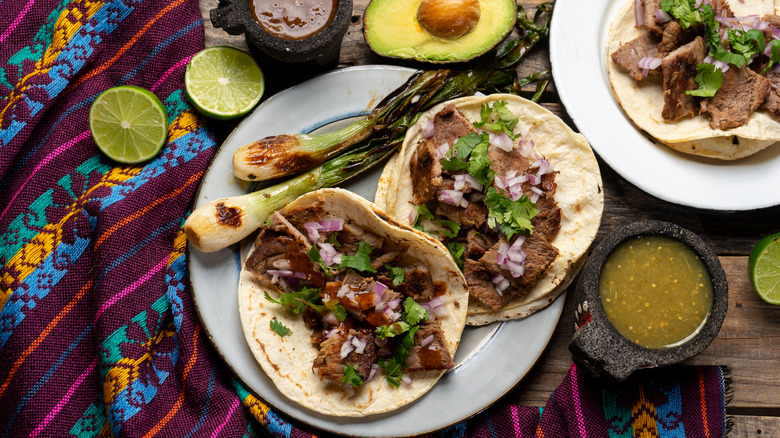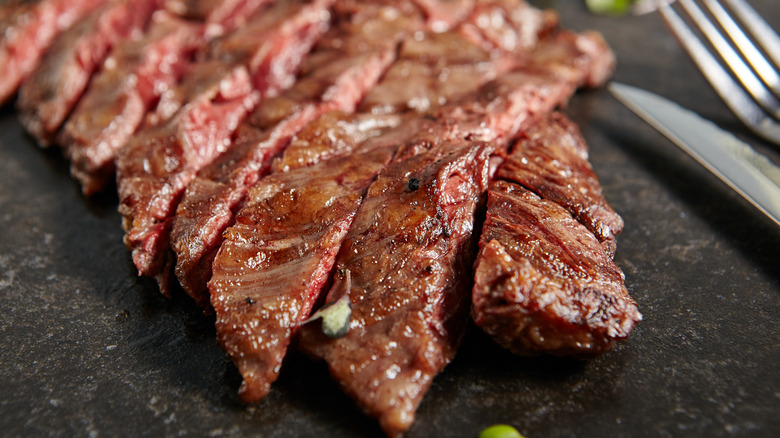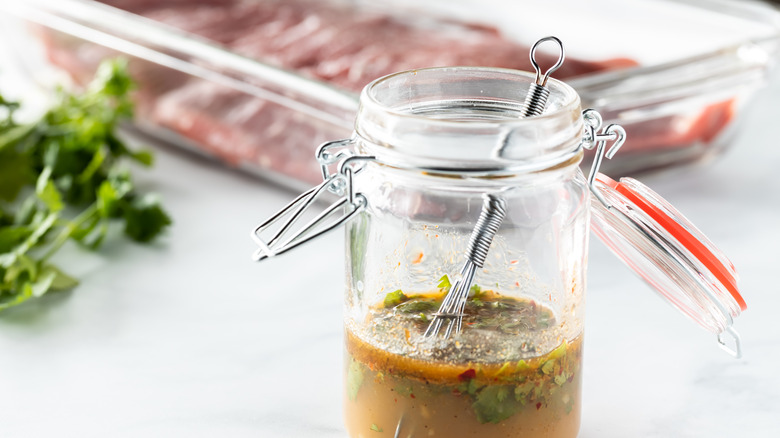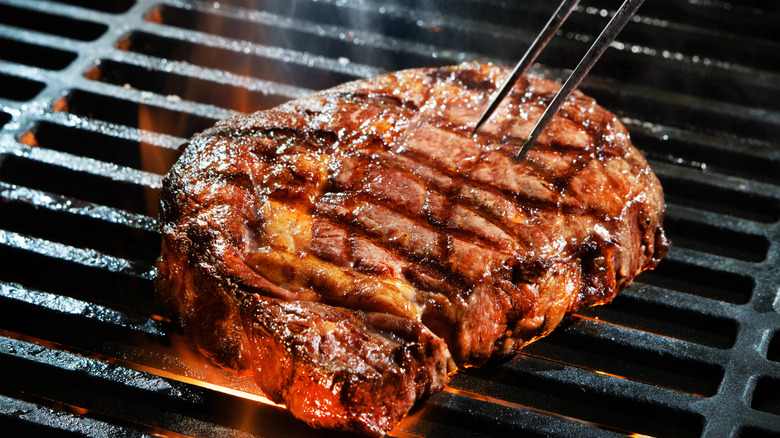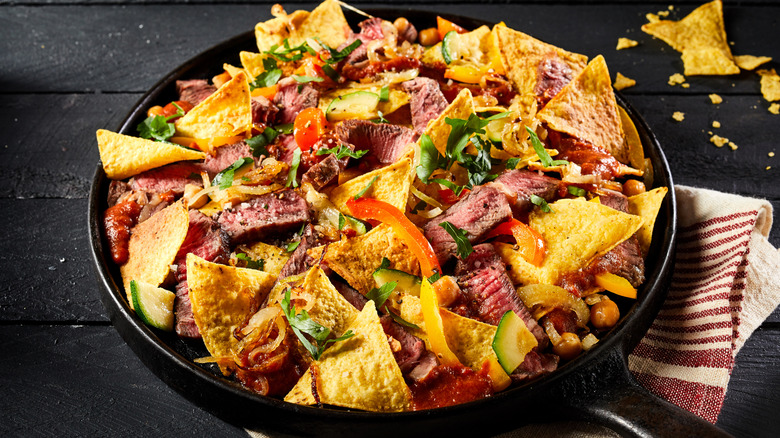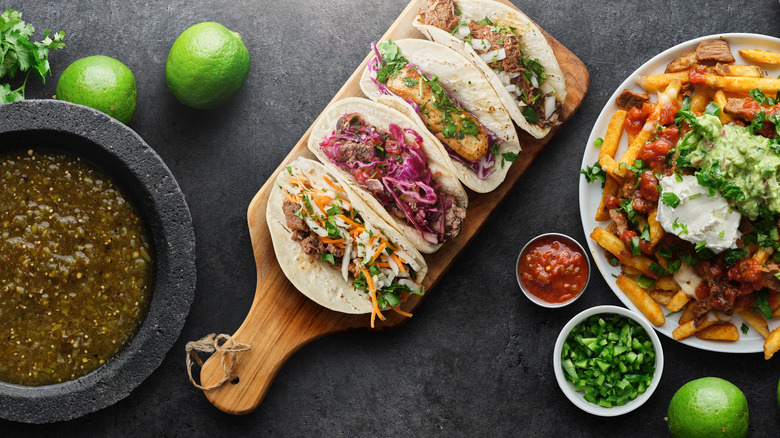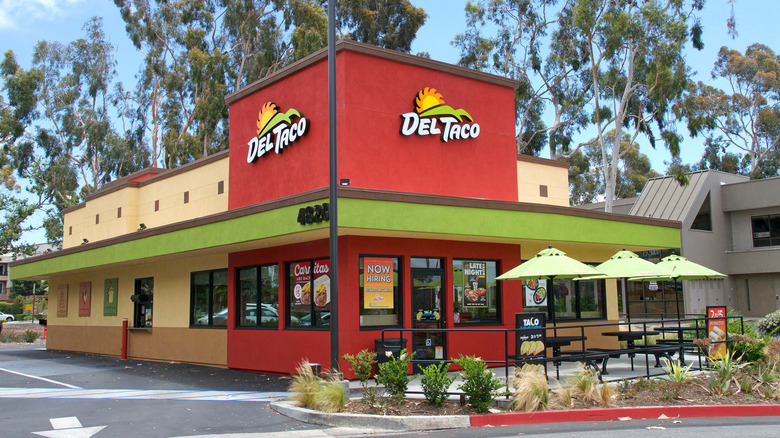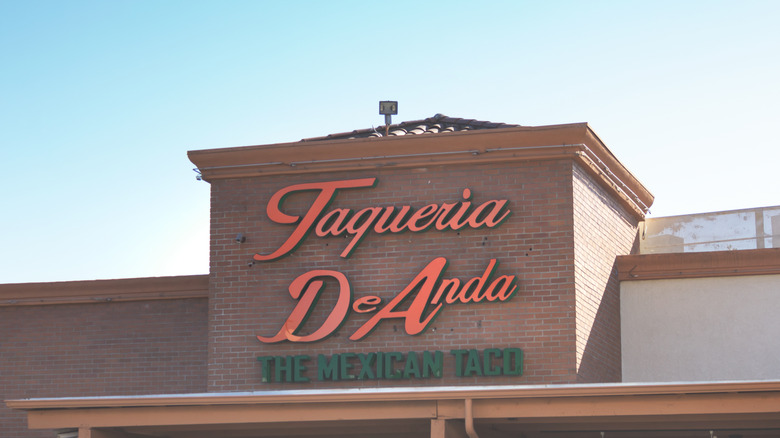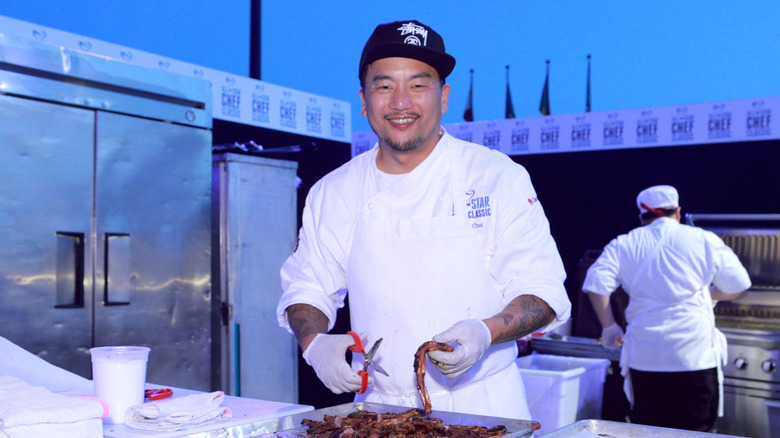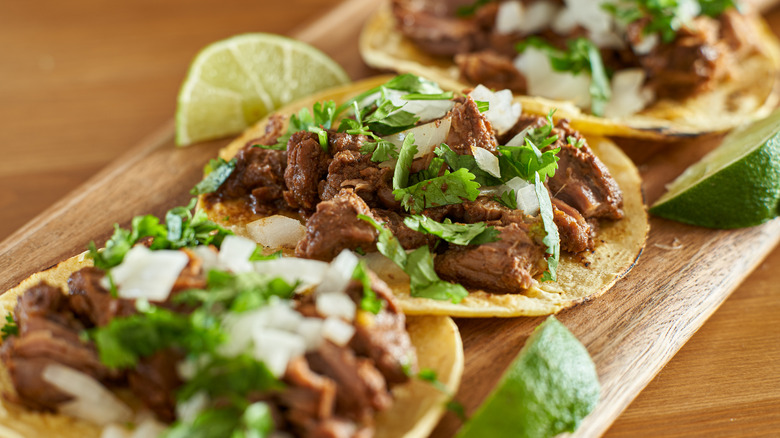The Untold Truth Of Carne Asada
If you're looking for a simple, portable, exceptionally flavorful Mexican dish, chances are you'll be ordering a street taco. While there are plenty of fillings to choose from, it's hard to go wrong with delicious carne asada. Seriously though — could a bite be any more perfect? Grilled steak topped with chopped cilantro, white onions, and a dribble of salsa to taste, all riding atop a fresh flour or corn tortilla? Already that sounds like edible heaven, but there's more to this Mexican culinary treat than meets the eye.
From understanding its roots in Northern Mexico and role as a social fixture within the community to tips on preparing the dish at home including marinades, which charcoal is best, and choosing the right cut of beef, we're here to unveil the untold truth of carne asada. Fire up the grill or have your delivery app open and ready, because if you're anything like us, reading all about it will have you craving carne asada stat!
Carne asada is a Mexican delicacy from Sonora
We all love the complex, fresh flavors present in a carne asada taco — unless you're of the vegetarian or vegan persuasion — but to fully grasp the importance of the grilled steak dish in Mexican culture, we have to look to its origins. Carne Asada is rooted in the centuries old practice of raising herds of cattle in Northern Mexico. The ranching tradition in Sonora dates back to the 1500s when Spanish colonizers first arrived in North America (via the Los Angeles Times). According to Taste Atlas, it was during that time that a dish of grilled beef sliced thin, and then stuffed into a corn tortilla along with a variety of toppings came to be. And thus, the taco was born. Carne asada became a local fixture as the cow business boomed — per the Los Angeles Times, by the 1950s, 85% of Sonora was used for cattle ranching.
In northern states like Sonora, carne asada is much more than a snack. According to The New York Times, the various facets of carne asada represent the agricultural landscape of Sonora in its use of steak from the lucrative ranching industry and choosing flour over corn tortillas to make ample use of the region's large wheat crop. In fact, while you might think you know all there is to know about carne asada, you haven't truly tried the dish until you've experienced carne asada in cities like Nogales where the dish originated.
Carne asada is a social staple
Truly a social food, carne asada is the perfect way to gather your community together. Rather than head straight to the closest restaurant listing carne asada on the menu, think about grilling your own carne asada at home to connect to the social roots of the meal. Just like a BBQ, preparing carne asada is traditionally a go-to for large celebrations, according to El Pollo Norteño. "In Mexico and the American Southwest, you will find that Carne Asada is the Mexican equivalent of Barbecue. I mean that in the party sense of the word. Traditionally a large fire pit is used to prepare this party, but you can use whatever you have," food writer Derrick Riches told Dallas Observer.
Putting some homemade carne asada front and center when planning meals for the week is a great excuse to call up your family and friends and fire up the grill. While the focus is on the feast, grilling carne asada is a great excuse to get the gang back together and catch up in the open air. Depending on your region, grilling might be a strictly spring or summer activity, but gathering together to sear the steak as a group — whether you're huddled around a backyard barbecue or a countertop grill in the great indoors — helps build community and connects to the celebratory roots of this northern Mexican dish.
Carne asada was political
Twentieth-century Mexican writer José Vasconcelos allegedly once said "Culture ends where carne asada begins," stigmatizing the Northern Mexican appreciation for the meal for its lack of gentility and sparking debate. First things first, who was Vasconcelos and why do we care when he's so obviously wrong about one the best ways to consume steak? Well, according to the Texas Archival Resources Online, Vasconcelos was a prominent intellectual, writer, and politician active during the years surrounding the Mexican Revolution. While he's certainly not a chef, he did serve as Mexico's Secretary of Public Education. His remarks on carne asada referred to the way Sonora was perceived as rather rough and ready in comparison with the rest of Mexico.
Was that assessment fair? Not really, seeing as a barbecue is a great way to gather a community together regardless of one's socio-economic status. Nonetheless, it paints a picture of the way Mexican intellectuals at the time were working to shape a distinctly Mexican identity following the Mexican Revolution — even if it meant excluding certain cultural elements in the process. While Vasconcelos didn't succeed in alienating Mexicans from carne asada, he remains a funny footnote in the cultural history of the dish.
The right cut of steak matters
The term "carne asada" may mean "grilled meat" in Spanish, but not any cut of beef will do the trick. The best cuts of meat for carne asada are the skirt or flank steak. Both flank and skirt steak are recommended because they are lean, flavorful cuts, though skirt steak tends to be more tender. The key to avoiding rubbery or dry carne asada is to make sure you nail the cooking time. Based on the composition of the meat, these cuts are predisposed to coming out too dry if you don't keep an eye on the grill.
Marinating skirt steak before grilling will ensure optimal flavor, but it's even more important to avoid overcooking the steak. When in doubt, stick to five minutes or less for a medium rare steak. Once the steak is grilled to perfection, Simply Recipes recommends slicing the meat against the grain in order to ensure it's tender when serving.
A marinade makes a big difference
When it comes to carne asada, your choice of marinade is a huge game changer. While traditionalists contend that salt should be the only addition (via The New York Times), most carne asada recipes include additional spices to maximize flavor. Marinating your steak before you start cooking will not only have a big impact on taste, but it will also improve the texture of your beef. The secret? Lime. Lime juice is highly acidic, which helps break down the muscle fibers to tenderize them, according to Our Everyday Life.
Start with lime juice and add spices like salt, pepper, Mexican oregano, and a healthy pinch of minced, raw garlic. If you like things on the spicy side, feel free to add in cumin and paprika — or even some jalapeños for an added kick. Leaving your steak to marinate for at least two hours is best if you want to be sure your carne asada will be at peak flavor, but if you're short on time, a mere 30 minutes will do. Just be sure that all of the steak is covered, whether you use an oversized ziplock bag or a kitchen bowl, to ensure that the marinade is distributed equally. If you want to skip the additional time it takes to marinate your steak to perfection, ask your local grocery store or butcher if they sell pre-marinated carne asada.
Mesquite charcoal enhances the smoky flavor
Carne asada can be seasoned in a variety of different ways or served up simply grilled, but to ensure that you're snacking on the best carne asada you can find, start with charcoal coals to enhance the taste of the marinated meat with smoky flavor. According to the New York Times, mesquite is the preferred type of charcoal for grilling carne asada. While technically any kind of charcoal will get the job done, you'd be missing out on a world of flavor and sidestepping tradition if you skipped out on mesquite.
Why mesquite? Desert USA notes that the drought-resistant mesquite tree can be found throughout the desert region. Beyond convenience, opting for mesquite charcoal when you fire up the grill gives carne asada a bold, smoky taste — not unlike that of Texas BBQ. If you can't get your hands on mesquite charcoal, don't despair. Carne asada will still taste great cooked over any charcoal you choose. And though you'll be sacrificing smokiness, feel free to cook your steak using a gas grill or even a cast iron pan.
Why does it taste so good even if you skimp on seasoning?
You instantly know the difference between boiled and grilled meat. We don't know who's still out there boiling their proteins, but if that's you, please stop. Skipping the process of grilling, baking, or pan-frying your meat cancels out any opportunity for that delicious charred or caramelized taste you know and love. We might consider this transformation from raw steak to carne asada simply a matter of "cooking," but you owe that instantly recognizable flavor to the Maillard reaction.
For anyone who geeks out on chemistry, this one's for you! What's happening here? According to Science of Cooking, "the Maillard reaction is a chemical reaction between an amino acid and a reducing sugar, usually requiring the addition of heat." This chemical reaction creates new flavors and aromas within the food while cooking. Not only does the Maillard reaction change the taste of your meat, but it also produces the browning that we usually see as a sign that your food is cooked and ready to plate.
Carne asada is a versatile ingredient
When someone suggests ordering carne asada, the first thing you think of is probably a taco. Tacos are always appetizing, but there are even more options available to you than you'd think! Like most proteins, carne asada works well within many types of Mexican dishes, including burritos, and quesadillas. You can serve the steak with tortilla chips, scattered across a plate of nachos, or even with ... french fries!
San Diego restaurant Lolita's Tacos claims to have invented carne asada fries in the 1990s, KJZZ reports. Since then, the dish has a popular San Diego treat. By combining the standout flavors of your favorite Mexican order with the humble french fry, you can truly have it all: the spicy zing of a carne asada taco and the comforting hug of a your favorite carb. You can even make your own carne asada fries at home. Don't worry — the fries can be frozen! Concentrating your culinary prowess on the carne asada and get ready to serve up a new take on this Mexican steak that will have dinner party guests begging for more.
Mouth-watering additions to your carne asada
Technically, while carne asada tastes amazing all on its own, the meat is simply the main protein. Once you've finished grilling your carne asada, what you decide to do with your marinated, charred steak is up to you! Most people opt for carne asada tacos, and what is a taco without toppings? Cilantro and chopped green onions are typical additions, though you are more than welcome to branch out by including a scoop of homemade guacamole or a sprinkle of shredded cheese.
If you're a fan of spice, don't forget the salsa! Mixing up a mild pico de gallo or spicy salsa roja at home and pairing it with your carne asada is a game changer. You can even just add a few dashes of grocery store hot sauce — we're big fans of Valentina Salsa Picante from Guadalajara, Jalisco for its balanced flavor profile and a simple list of ingredients you can understand without breaking out a dictionary.
Carne asada is a hit with fast-food chains
If you're dying for a carne asada fix, you're in luck because it's a pretty popular option — even at chain restaurants. Fast food favorites such as Chipotle, Rubio's, Del Taco, and Taco Bell serve up carne asada in a variety of ways, from your basic tacos, bowls, and burritos, to more unconventional fare like Del Taco's Carne Asada Stuffed Quesadilla Taco.
Depending on the offerings in your area, it's best prepare to yourself for a range of quality. Not all fast-food carne asada, however, is created equal. Watch out for rubbery, overcooked steak masquerading as carne asada or flavorless meat desperately lacking seasoning buried under a mountain of toppings like shredded cheese or hot sauce. If possible, try to take a peek into the kitchen and see if the meat is being grilled to order.
No matter which fast-food chain you choose, paying attention to whether the carne asada is the main focus of the meal can help you choose an item that is crafted with care.
Seek out at carne asada at a local spot
Fast food may be convenient, but it can't compete with the specialized expertise at a local small business. Rather than try to do it all and hop on the bandwagon for trending recipes for the sake of making a buck, Mom-and-Pops approach their menu with pride and integrity. If you're looking for the best carne asada in your area, look no further than a family-owned restaurant for the real deal, like Taqueria de Anda in Orange County, California. When Rafael "Don Rafa" De Anda moved from Jalisco to Fullerton, he brought the traditional flavors from his original taco cart to a new scene. In fact, Taqueria de Anda continues to use the original family recipes that made their original venture a success, the Los Angeles Times reports. One of the stars of the original menu? Carne Asada. Rather than overloading the taco with fancy fixings, they stick to cilantro, onion, and salsa, allowing the carne asada to take the lead in terms of flavor.
As documented in the Netflix show Taco Chronicles, some of the top taquerias grilling up carne asada can be found right across the border in Tijuana. If you're looking for a carne asada road trip, Tacos El Franc in Tijuana is a must-try. According to The San Diego Union-Tribune, their carne asada owes its unique taste to a marinade mixture containing of oranges, garlic salt, olive oil, oregano, salt and pepper, and a top secret seasoning.
It may be a Mexican dish, but there's always room to experiment
Thanks to the simple seasoning composition of a classic carne asada — a lime marinade with salt, pepper, and garlic will do —it's easy to mix things up if you're in the mood for a change of pace. Take it from chef Roy Choi. Serving up Korean-Mexican fusion fare at Los Angeles-based food truck Kogi, Choi combines East and West culinary traditions to create a carne asada with a complex flavor profile.
The secret? Definitely don't skip the marinade and prepare to get creative. When it comes to carne asada, Choi suggests a marinade combining garlic, citrus, kiwi, beer, and mirin. What's mirin? A Japanese rice wine, similar to saké. The effect? A carne asada zinging with flavor that's perfect for tacos or even a kimchi-topped burrito bowl to emphasize the unique taste of the marinade and use up some of that pandemic rice hiding in the back of your kitchen pantry.
Carne asada is an easy DIY
There's an undeniable ease to ordering carne asada at your favorite Mexican restaurant, but if you're up for a quick and easy DIY culinary adventure, Mashed has your back. While recipes can feel complicated, there are only three main steps to keep in mind when making your own carne asada: grab the right cut of steak, marinate, and fire up the grill. While there are more carne asada recipes online than we can count, this is one of the easiest! Whether you're strictly a defroster or a culinary whiz, the keys to carne asada is a smoking hot grilling surface and copious amounts of liquid smoke to give the meat a smoky flavor regardless of whether you're grilling with charcoal.
Liquid smoke is exactly what the name suggests — it's smoke that has been liquified and bottled. Flavors often range from mesquite to applewood, and despite coming in a small bottle, pack a big punch! Adding liquid smoke to your marinate is a game-changer, allowing you to quickly maximize that smoky, mesquite flavor you know and love, without having to invest in a smoker. After marinating your steak for at least two hours, preheat your grill or frying pan, and get to sizzling. You'll know your carne asada is done after cooking each side for at least 3-5 minutes. Mashed advises you let your cooked carne asada rest for about ten minutes before slicing it in long, thin strips. After that, you're ready to serve!
